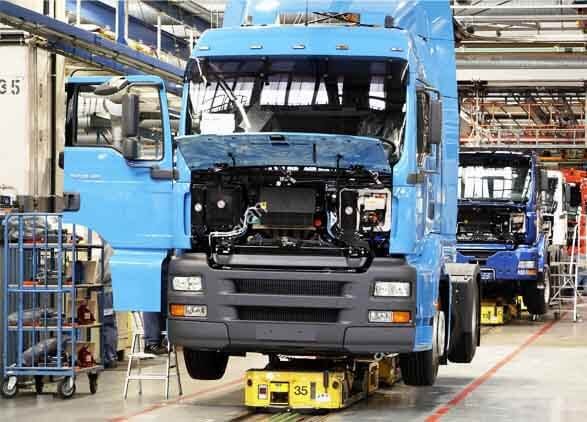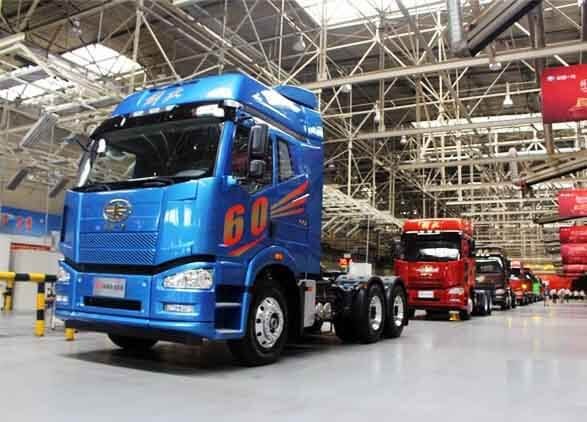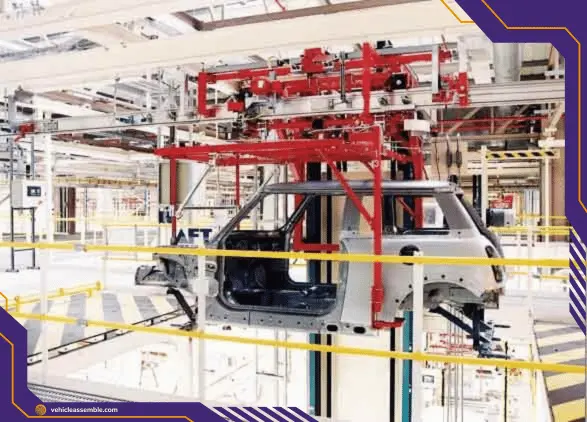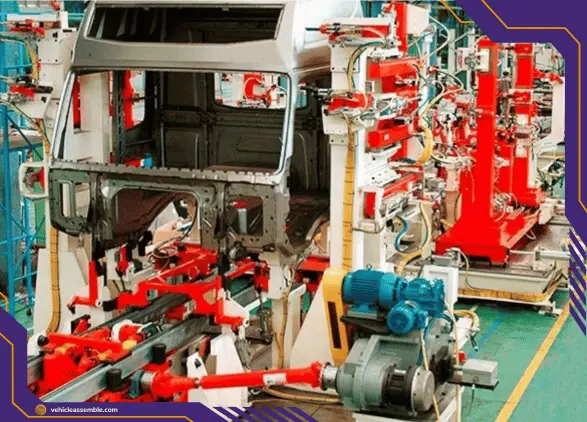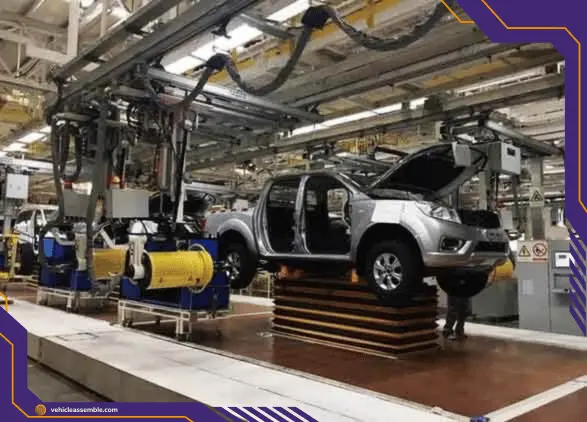Description
Truck Assembly Line: Revolutionizing Automotive Manufacturing
In today's fast-paced world, the automotive industry continues to evolve, striving for greater efficiency, productivity, and sustainability. One essential advancement that has significantly impacted this sector is the Truck Assembly Line. This revolutionary concept has streamlined the production of trucks, leading to increased output and cost-effectiveness. In this comprehensive article, we will delve into the inner workings of a Truck Assembly Line, exploring each step involved in bringing a truck to life and how it has changed the landscape of automotive manufacturing. Join us as we embark on a journey through the assembly line and uncover the secrets of this remarkable process.
Truck Assembly Line: An Overview
The Truck Assembly Line is a manufacturing process where various components and parts of a truck are systematically assembled sequentially. The assembly line comprises a series of workstations dedicated to a specific task. As the truck chassis moves along the line, skilled workers and specialized machines collaborate to add various components until the final truck rolls off the line, ready to hit the road.
Truck assembly operation process
Assembling the frame
A pair of frame rails are selected from stock lengths of C-channel. They are laid side-by-side and fed through an automatic drilling machine or punch to make holes for connecting cross-member brackets, engine mounts, and other frame-mounted components. A computer tells the device the size and location of the required holes along the length of the frame rails.
Small threaded studs are spot welded inside the C-section of the frame rails. The airlines for the brakes and the electrical wires for the lights and sensors are placed inside the frame rails and are secured with rubber-cushioned clamps fastened to the studs.
The brackets for the frame cross members are bolted in place using high-strength bolts or self-clinching fasteners. The left and right frame rails are then positioned opposite each other, and the cross-members are added. The frame now resembles a long ladder with the rails as the sides and the cross members as the rungs.
Other frame-mounted components—such as engine mounts, suspension brackets, and air tanks—are bolted in place.
Installing the axles and suspensions
The front and rear axles are fitted with the proper hubs (the round ends to which the wheels are attached), brakes, and brake drums. The axles are clamped to the suspensions using long U-bolts. Some breaks use long leaf springs, while others use inflated rubber airbags.
The front and rear axles and suspensions are lifted into place and attached to the suspension brackets on the frame. The shock absorbers are connected between the axles and the frame.
Finishing the frame
Up until this point, the frame assembly is usually moved from station to station either manually or with overhead hoists. The frame is placed on moveable support and begins moving down the assembly line. The air tanks and brake chambers are connected to the airlines, and the lights and sensors are connected to the proper wires.
If the vehicle is to be a tractor, the fifth wheel is lifted onto the frame and bolted into place. From this point on, the frame assembly with the axles, suspensions, and frame-mounted components is called the chassis.
Painting the chassis
All components not to be painted are covered with masking tape or paper. The chassis then moves into a paint booth with compressed air spray guns. Most truck manufacturers require that all parts be received with a primer coat of paint, so priming is unnecessary.
After the chassis has been thoroughly painted and visually checked, it moves into a drying oven, where hot air dries the paint. The masking tape and paper are removed as it emerges from the oven.
Installing the engine and transmission
The engine and transmission are brought into the plant alongside the assembly line. Almost all trucks now use diesel engines. The clutch is installed, and the information is bolted onto the rear of the machine. The fan, alternator, and other engine components are installed and connected with hoses and electrical wiring.
The finished engine/transmission package is then hoisted using lifting eyes that are part of the engine and lowered onto the engine mounts in the chassis, which is bolted in place. The radiator assembly is bolted onto its brackets ahead of the engine. The fuel lines, air hoses, starter cables, and coolant hoses are connected to the machine.
Finishing the chassis
The fuel tanks are secured to their frame brackets and connected to the fuel lines. Batteries are attached to the box but not related to prevent accidental sparking.
The tires are mounted on the wheels at a workstation adjacent to the assembly line. Aluminum wheels are left natural or may be polished. Steel wheels are painted before the tires are mounted. The tires and wheels are mounted on the axle hubs, and the lug nuts are tightened. At this point, the truck is taken off its moveable supports and sits on its tires.
Assembling the cob, hood, and sleeper
The cab and sleeper substructures are welded or fastened together in jigs to hold the pieces in place. The substructures strengthen the cab and sleeper and provide fastening points for the outer skin and inner upholstery and trim.
The outer skin pieces are welded or fastened in place. This includes the sides, back, floor, and roof pieces. The joints between pieces are overlapped and sealed to prevent leaks. The cab and sleeper doors are secured to the hinges.
The hood is usually a molded plastic piece shipped to the plant without any hardware attached. The hood is checked for rough surfaces and is sanded as required.
Painting the cab, hood, and sleeper
Each truck's cab, hood, and sleeper are painted simultaneously. The surfaces are cleaned, and the areas not to be painted are masked off with paper or tape. If a paint design such as a different color stripe is specified, the stripe area is painted first, then the line is masked off, and the primary body color is applied on a second pass through the paint booth. After each receipt, the cab, hood, and sleeper go through a drying oven. After the final pass, the masking is removed, and the paint is visually inspected.
In most plants, the trucks move along an assembly line as components are added by different groups of workers at successive workstations. The car starts with a frame assembly that acts as the "backbone" of the truck and finishes with the completed, fully operational vehicle being driven off the end of the assembly line under its power.
Finishing the cab, hood, and sleeper
The grille, headlight brackets, hood hinges and latches, and the manufacturer's emblem or name are installed on the hood. The finished hood is then stored alongside the assembly line.
The exterior components of the cab and sleeper—the grab handles, mirrors, visors, etc.—are mounted before any work on the interior begins.
The instrument panel is attached to the dashboard. The gauges, warning lights, and switches are installed and hooked to the appropriate wires and hoses. The entire dashboard assembly is installed in the cab, along with the cab heater system and steering column.
Pads of foam insulation are placed in the cab and sleeper walls, and the interior upholstery pieces are secured on the walls and ceiling. Plastic trim pieces are screwed in place to cover exposed edges and seams. The floor is covered with a rubber mat or fabric carpet laminated to a sound-absorbing pad, and the edges are secured. The seats are installed on top of the floor covering and secured with bolts into the main cab structure.
The windshield and rear windows are carefully pressed into place. A rubber gasket seals the edges between the glass and the cab structure.
Installing the cab, hood, and sleeper
The completed cab is lowered onto the chassis and bolted to its mounts. The sleeper is bolted in place behind the cab. The steering column is connected to the steering box. The transmission shift lever is installed through the floorboard, and the clutch pedal is attached to the clutch linkage.
After all the cab connections are made, the hood is lowered onto the chassis and secured to its pivot point. The bumper is attached to brackets on the frame. Wire connections are made for the headlights and front turn signals.
Adding fluids
The engine, radiator, and other reservoirs are filled, and the air conditioning system is charged. A small amount of diesel fuel is added to the tanks for a short road test. The steering wheel, which had been left out to give working room in the cab, is now installed, and the batteries are connected. The completed truck is then driven off the end of the assembly line.
Aligning the front and rear axles
To ensure that the front and rear axles are parallel to each other and perpendicular to the centerline of the frame, the truck is placed on a laser alignment machine, and the axle positions are adjusted as required. The angle of the wheels is also changed. This ensures that the truck will handle properly and have satisfactory tire life.
Testing the completed truck
The truck is driven onto a dynamometer and secured with chains. The truck's rear wheels sit on rollers set into the ground and connected to the dynamometer. As the truck engine spins the rear wheels on the rollers, the dynamometer measures the engine power to ensure it is operating correctly.
The truck is driven slowly through a water spray booth as the driver checks for cab leaks. The driver then takes the truck for a short drive to check the overall operation. If the truck passes all the tests, it is parked on the "ready row" to be delivered to the dealer.
The Advantages of Truck Assembly Lines
Implementing Truck Assembly Lines has led to many advantages that have transformed the automotive manufacturing industry.
1. Increased Efficiency and Productivity
The introduction of assembly lines has significantly improved the efficiency and productivity of truck manufacturing. By breaking down the production process into smaller, specialized tasks, workers can focus on their specific roles, leading to faster and more streamlined production.
2. Cost-Effectiveness
Assembly lines have played a key role in reducing production costs. With optimized processes and reduced assembly time, manufacturers can produce trucks at a lower price, making them more accessible to consumers.
3. Consistent Quality
Truck Assembly Lines ensure high consistency and quality in the final product. Each truck goes through standardized processes and quality checks, minimizing variations and defects.
4. Worker Safety
Modern assembly lines are designed with worker safety in mind. Automating specific tasks and providing ergonomic workstations reduces the risk of workplace injuries.
5. Technological Integration
Truck Assembly Lines have embraced technological advancements. Automation and robotics have been integrated into the process, enhancing efficiency and precision.
6. Environmental Sustainability
By optimizing processes and reducing waste, assembly lines contribute to a more environmentally sustainable manufacturing approach.
Innovations in Truck Assembly Lines
The automotive manufacturing world constantly evolves, and Truck Assembly Lines have not been left behind. Advancements in technology and engineering have led to innovative changes in assembly line processes.
1. Robotics and Automation
The integration of robotics and automation has revolutionized truck assembly lines. Robots are now employed for repetitive and labor-intensive tasks, improving precision and efficiency while reducing the strain on human workers.
2. IoT and Data Analytics
The Internet of Things (IoT) has made it possible to collect real-time data from various stages of the assembly line. Data analytics and AI-driven algorithms analyze this data, identifying patterns and areas for improvement, ultimately optimizing the production process.
3. Collaborative Robots (Cobots)
Collaborative robots, also known as cobots, work hand in hand with human workers. These robots are designed to assist humans in tasks that require precision and strength, fostering a safer and more productive work environment.
4. 3D Printing
3D printing, also known as additive manufacturing, has opened new possibilities in the truck assembly line. It allows for rapidly producing customized parts and components, reducing lead times and material waste.
5. Augmented Reality (AR)
AR is being used to train assembly line workers, offering interactive and immersive guidance. This technology aids in reducing training time and minimizing errors during assembly.
6. Green Manufacturing Practices
With a growing emphasis on environmental sustainability, truck assembly lines are adopting green manufacturing practices. This includes recycling materials, using energy-efficient processes, and reducing emissions during production.
FAQs
Q: How has the introduction of Truck Assembly Lines impacted production time?
A: Introducing Truck Assembly Lines has significantly reduced production time, allowing manufacturers to produce trucks faster than traditional methods.
Q: Are all trucks manufactured using assembly lines?
A: While not all trucks are manufactured using assembly lines, most modern trucks are produced through this efficient method.
Q: How do assembly lines contribute to worker safety?
A: Assembly lines prioritize worker safety by automating hazardous tasks, providing ergonomic workstations, and emphasizing safety protocols.
Q: What impact do assembly lines have on environmental sustainability?
A: Assembly lines optimize production processes, reduce waste, and minimize resource consumption, contributing to a more environmentally sustainable manufacturing approach.
Q: How do assembly lines ensure consistent quality in trucks?
A: Assembly lines maintain consistent quality through standardized processes and stringent quality control checks at each production stage. Each task is meticulously designed and monitored to ensure that every truck meets the same high-quality standards.
Conclusion
The Truck Assembly Line has undeniably revolutionized the automotive manufacturing industry. From its early beginnings to today's modern, technologically advanced lines, assembly lines have paved the way for increased efficiency, cost-effectiveness, and quality in truck production. As technology progresses, the future of truck assembly lines holds exciting possibilities for intelligent, sustainable, and highly productive manufacturing processes.
Next time you see a truck cruising down the highway, remember the incredible journey from the assembly line to the open road, a testament to human ingenuity and innovation.


